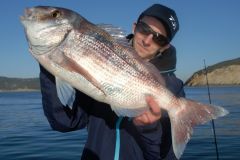The upside-down bibi technique can be used with all types of bibi. Here, we use a Mediterranean bibi as an example. Slightly smaller than Asian bibis, it's more resistant and, above all, more fragrant.

To begin, take your bibi and use a pair of scissors to cut off both ends of the worm.

Then, still using scissors, open the bibi along its entire length.

Once this stage has been completed, you may or may not need to empty the bibi of its entrails. There are two possible ways of doing this:
- Use fully gutted bibi skin to enhance the visual appeal of the bait presented and to take advantage of the flesh's resistance for long-distance, hard-hitting casts.
- Keep the viscera to optimize the olfactory aspect of the bibi.

As a rule, the bibi is completely emptied of its viscera, revealing a pinkish-colored nerve that must be removed to break the worm's rigidity.

Using a fine worm needle, gently remove the entire length of the nerve.
Once this step has been completed, the remaining skin of the bibi, or a simple piece of bibi, will be tied over a needle before being put on the hook. Hold the bibi firmly around the needle.


Slowly and meticulously tie the worm along its entire length, creating a small, uniform coil. Finally, a few half-keys and the ligature will stay in place.

Then take your leader thread, thread it through the needle and gently slide the turned-over and tied bib over your hook.


The rig is now ready. Fishing with the bibi turned upside down will allow you to cast much harder and therefore gain considerably in casting distance. Another way of prospecting and fishing with a bibi. A technique that gives very good results on gilthead bream and other sparids, sea bass and even paddlefish.

 /
/ 











